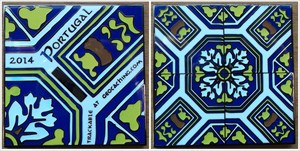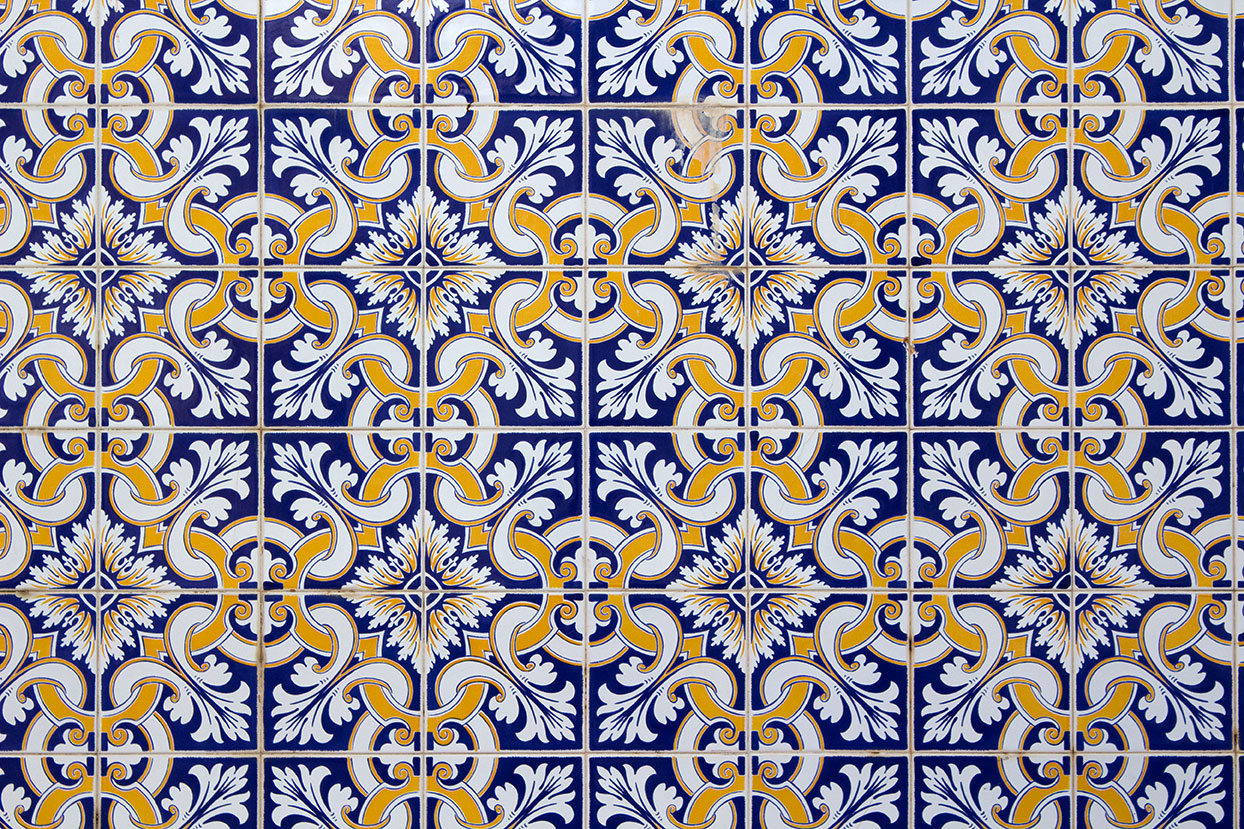This is collectible.


O azulejo é uma das marcas mais distintivas daquilo que é a cultura portuguesa. A constituição de muitos dos edifícios e dos espaços públicos lusos são ornamentados e complementados com as figuras representadas nesses espaços de tonalidade azul. Em muitos deles, está condensada a história e a memória de milhares de lusitanos, tanto a daqueles que dão vida a essas representações, como aqueles que se encontram honrados e homenageados em várias vilas. As paredes nacionais, ao contrário de tantas outras, não se fecham, abrindo portais para outras dimensões temporais, para tempos remotos, onde a recordação ainda pulsa bem na proximidade dos que caminham e dos que tocam em consagrada realização.
Embora proeminente e ressurgente na cultura portuguesa, o azulejo tem derivações árabes na própria semântica. O termo azzellj significa pequena pedra polida, e foi usado para designar o próprio mosaico usado na arte bizantina. Porém, concernindo tal e qual àquilo que conhecemos hoje, designa uma peça de cerâmica de espessura pequena, normalmente quadrada, com uma das faces vidradas. Formatada tradicionalmente em 15×15, resulta da cozedura de esmalte, que reveste e torna impermeável e resplandecente essa peça quadrada. Diante de divisões e de contextos húmidos, tornou-se aplicado com regularidade, assentindo em resistência e em parcas despesas. Podendo-se desdobrar em lisas, relevadas, monocromáticas ou policromáticas, as peças em azulejo foram usadas, principalmente, no revestimento de obras arquitetónicas, aplicando-se tanto nos interiores, como nos exteriores, e expondo vários episódios e cenas alegóricas, religiosas e históricas, estando dependente do contexto do seu uso. O seu alinhamento como ornamento passou a, não só apresentar-se como um complemento às várias tendências artísticas, mas também como uma estetização artística e identitária do espaço que incorporam, que representam, e em que se presenciam.
Curiosamente, já em tempos do Antigo Egito e da Mesopotâmia que se evidencia o emprego do azulejo, tendo conhecido expansão geográfica e expressiva a partir da presença e manifestação islâmicas na região mediterrânica, propagando-se por toda a Península Ibérica. É no Oriente que se consagra a produção de revestimentos para a própria porcelana chinesa, e a sua arte, à proporção da dinâmica de alargamento islâmico, alcançou as próprias regiões onde se fez sentir. Assim, artesãos muçulmanos fixaram-se em vários pontos da península, e, tendencialmente, plantaram as sementes da arquitetura mudéjar em solo espanhol, e da arte do azulejo em Portugal. Tudo isto bem a meio deste milénio. Nisto, importou, também, a tradição cerâmica portuguesa, que abdicou de importar de Espanha para fazer o seu próprio azulejo, e que propagou esse mesmo engenho para as colónias que detinha então. O sentimento de encanto foi imediato, e perspetivava-se uma eternização destes mosaicos naquilo que seria uma herança para os artesãos ibéricos.
- rastreável em Geocaching.com, com ícone próprio:
![[Geocoin Icon]](https://www.geocaching.com/images/WptTypes/7580.gif)


The tile is one of the most distinctive marks of what is the Portuguese culture. The constitution of many of the buildings and the Portuguese public spaces are ornamented and complemented with the figures represented in these spaces of blue tonality. In many of them, the history and memory of thousands of Lusitanians is condensed, both to those who give life to these representations, and those who are honored and honored in several villages. The national walls, unlike so many others, do not close, opening portals to other temporal dimensions, to times remote, where the remembrance still pulsates well in the proximity of those who walk and those who touch in consecrated accomplishment.
Although prominent and resurgent in Portuguese culture, the tile has Arab derivations in its own semantics. The term azzellj means small polished stone, and was used to designate the own mosaic used in Byzantine art. However, concerning what we know today, it designates a piece of ceramic of small thickness, usually square, with one of the glazed faces. Traditionally shaped in 15 × 15, it results from the firing of enamel, which coats and renders impermeable and resplendent this square piece. Faced with divisions and damp contexts, it became applied regularly, based on resistance and sparing expenses. It is possible to unfold in flat, detached, monochromatic or polychromatic pieces. The tiles have been used mainly in the coating of architectural works, applying both in the interiors and exteriors, exposing various episodes and allegorical, religious and historical scenes , being dependent on the context of its use. Their alignment as an ornament has not only presented itself as a complement to the various artistic tendencies, but also as an artistic and identity aesthetization of the space they incorporate, represent and in which they are present.
Curiously, already in times of Ancient Egypt and Mesopotamia that the use of the tile is evident, having known geographical and expressive expansion from the Islamic presence and manifestation in the Mediterranean region, spreading all over the Iberian Peninsula. It is in the East that the production of coatings for the Chinese porcelain itself is consecrated, and their art, in proportion to the dynamics of Islamic enlargement, reached the very regions where it was felt. Thus, Muslim artisans settled in several points of the peninsula, and, tendentially, planted the seeds of the Mudejar architecture in Spanish soil, and of the art of the tile in Portugal. All this well in the middle of this millennium. In this, he also imported the Portuguese ceramic tradition, which he abdicated to import from Spain to make his own tile, and which propagated this same ingenuity to the colonies he held at that time. The feeling of charm was immediate, and an eternity of these mosaics was envisaged in what would be an inheritance for the Iberian artisans.
- trackable at Geocaching.com, with its own icon:
![[Geocoin Icon]](https://www.geocaching.com/images/WptTypes/7580.gif)
